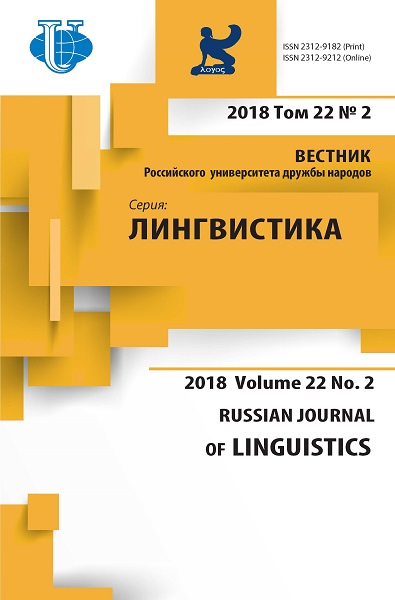NEW WORLD BASQUE TOPONYMY IN THE DIALOGUE OF LANGUAGES AND CULTURES
- 作者: CHESNOKOVA O.S.1, TALAVERA-IBARRA P.L.2, BOLOTINA K.E.1
-
隶属关系:
- Рeoples’ Friendship University of Russia (RUDN University)
- Missouri Southern State University
- 期: 卷 22, 编号 2 (2018)
- 页面: 251-264
- 栏目: 语言文化意识
- URL: https://journals.rudn.ru/linguistics/article/view/18586
- DOI: https://doi.org/10.22363/2312-9182-2018-22-2-251-264
如何引用文章
全文:
详细
作者简介
OLGA CHESNOKOVA
Рeoples’ Friendship University of Russia (RUDN University)
Email: tchesnokova_olga@mail.ru
Full Professor at the Department of Foreign Languages at RUDN University. He has authored more than 190 publications on diversity in the Spanish language, intercultural communication, linguistic contact, Spanish-Russian-English translation, and toponymy. Altogether, 12 students have defended their PhD dissertations under her supervision, six on Toponymy in Latin America, Canada, and the USA 6 Miklukho-Maklaya St., Moscow, 117198, Russian Federation
PEDRO TALAVERA-IBARRA
Missouri Southern State University
Email: Talavera-P@mssu.edu
PhD in Comparative Literature (UT, Austin Texas, USA), full-time Professor at the Department of Foreign Languages of Missouri Southern State University, USA. He is a specialist on Spanish and Latin American civilizations, the author of 40 publications and original methodologies of teaching Spanish, and has more than 30 years of teaching and research experience in Mexico and the USA 950 Newman Rd., Joplin, МО 64801, USA
KSENIA BOLOTINA
Рeoples’ Friendship University of Russia (RUDN University)
Email: k.e.bolotina@gmail.com
PhD student completing her Doctoral dissertation and is devoted to the onomastics of Quebec, Canada and Quebec ethno specific discourse. She is the winner of the best postgraduate student award (Master of Linguistics) - 2015, awardee of the government scholarship for scientific research 2016-2018, and is a current participant of full employment PhD program at RUDN University 6 Miklukho-Maklaya St., Moscow, 117198, Russian Federation
参考
- Agud, Manuel (1973). Areas toponimicas en el País Vasco [Toponymical areas in the Basque Сountry (In Spanish)]. ASJU 7. 37-56. Retrieved from: http://www.ehu.es/ojs/index.php/asju. [Last viewed 09.09.17].
- Bakker, Peter (1989). ‘The language of the Coast Tribes is Half Basque’: A Basque-Amerindian Pidgin in Use between Europeans and Native Americans in North America, ca. 1540 - ca. 1640. Anthropological Linguistics, 31, 117-147.
- Bakker, Peter (1991). A Basque etymology for the Amerindian tribal name Iroquois. Annuario del Seminario de Filologia Vasca (ASJU Geh), 14 (2). Bizkaia: Universidad del País Vasco, 1119-1124.
- Bakhtin, Mikhail (1979). Aesthetics of Verbal Creativity. Moscow: Iskusstvo. (In Russ.)
- Bensone, Maxine (1994). 1001 Colorado place names. Illustrations by Robin Richards. Lawrence, KS: University Press of Kansas.
- Bolotina, Ksenia (2016). Quebec toponymy: linguistic-culturological analysis. Philological Sciences. Issues of Theory and Practice 2016. № 11. Part 3, 74-77.
- Caro Baroja, Julio (2004). The Basques. Translated from Spanish. Moscow: URSS. (In Russ.)
- Chesnokova, Olga, Talavera-Ibarra, Pedro Leonardo (2016). El diálogo de lenguas y culturas en la toponimia vasca. Ibero-American studies, 2(12). Мoscow: MGIMO University, 72-76.
- Chesnokova, Olga, Bolotina, Ksenia, Talavera-Ibarra, Pedro Leonardo (2017), Basque toponymy in the New World. Acta Onomastica, 1/LVIII/2017, 53-62.
- de Champlain, Samuel. (1613), (1632). Les voyages du sieur de Champlain Xaintongeois, capitaine ordinaire pour le roy, en la marine... Paris, éditions de 1613 et 1632.
- Egaña Goya, M. (1995). Les toponymes basques au Québec. Le Naturaliste Canadien. Hiver 1995. QC: Les Editions l’Ardoise, 54-57.
- González-Allende, Iker (coord.). (2016). El exilio vasco: estudios en homenaje al profesor José Angel Ascunce Arrieta. Madrid: Ediciones Deusto.
- Gudde, Erwin G. (2004). California Place Names. Berkeley: University of California Press.
- Harluxet, Xabier. (2003). La langue basque et quelques traces des basques au Quebec! Retrieved from: http://www.euskonews.com/0198zbk/kosmo19802fr.html. [Last viewed: 01.06.17].
- Igartua, Ivan, Zabaltza, Xabier. (2016). Breve historia de la lengua vasca.Donostia-San Sebastián: Instituto Vasco Etxeparre. Retrieved from: www.etxepareinstitutua.net. [Last viewed: 26.08.17].
- Il'ina, Anna. (2013). Inhomogeneity of toponymical naming units of English speaking Canada as an image of Canadian linguistic world view. Ph.D. thesis. (In Russ.).
- Kurlansky, Mark. (1999). The Basque History of the World. New York: Penguin Group.
- Loewen, Brad (2016). Interwined Enigmas: Basques and Saint Lawrence Iroquoians in the Sixteenth Century. Contact in the 16th century. Networks among Fishers, Foragers and Farmers. Edited by: Brad Loewen, Claude Chapdelaine. Mercury Series. Ottawa: University of Ottawa Press, 57-75.
- Martijn, Charles A. (1990). The Iroquoian Presence in the Estuary and Gulf of St. Lawrence River Valley: A Reevaluation. Man in the Northeast 40. Rindge, N.H.: Anthropological Research Center of Northern New England, 45-63.
- Michelena, Luis (1989). Apellidos vascos. San Sebastian: Cuarta edición.
- O’Hagan, John (2015). When the Basques Ruled California 1784-1834. Caldwell, Idaho: Caxton Press.
- Poirier, Jean (2006). La toponymie du Québec. Dictionnaire illustré - Noms et lieux du Québec. Quebec: LES PUBLICATIONS DU QUÉBEC. XXXIII-XLV.
- Pospelov, Evgeniy (1998). Geograficheskie nazvaniya stran mira: Toponimicheskiy slovar': Svyshe 5 000 edinits. [Geographic names of world’s countries: Toponymical dictionary: More than 5000 naming units. Moscow: AST. (In Russ.)].
- Rayburn, A. (2001). Naming Canada. Toronto: University of Toronto Press.
- Salaberri, Patxi, Salaberri Iker (2011). Basque Legacy in the New World: on the Surnames of Latin American Presidents - ASJU, xlv-2. Bizkaia: Universidad del País Vasco, 115-151.
- Sarkisian, Vahan (2000). Vascos y armenios: Documentos y materiales. Erevan: Asoghik.
- Sudar’, Galina (2007). Ispanskaya toponimiya [Spanish toponymy]. Moscow: RosNOU. (In Russ.).
- Tardivel, Louis (1991). Répertoire des emprunts du français aux langues étrangères. Quebec: Septentrion.
- Toña, Miguel (2015). Las listas de Podemos Euskadi abren una brecha con la dirección nacional, El País, 15 de noviembre de 2015. EDICIONES EL PAÍS S.L. Retrieved from: https://elpais.com/ccaa/2015/11/04/paisvasco/1446654187_649430.html [Last viewed: 15.09.17].
- Trinidad, Víctor (2014). Repetí el ascenso al cerro Euskadi para subir a su cima una ikurriña comprada en Durango. About Basque Country. Retrieved from: https://aboutbasquecountry.eus/2014/09/09/la-cima-vasca-mas-alta-tiene-3-615-metros-de-altura-y-esta-en-los-andes/ [Last viewed: 20.08.17].
- Zorroguieta, Jorge, Goyenechea, Mauricio (2012). Los vascos en la Argentina: familias y protagonismo. Anuario de la Fundación Vasco Argentina “Juan de Garay”. Buenos Aires.














